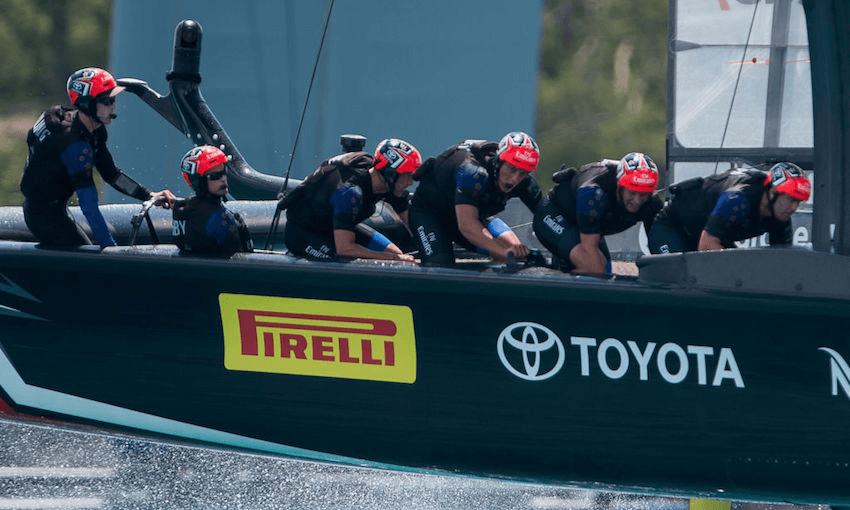In modern sport it’s hard to tell what’s more important: the hi-tech equipment, or the athlete themselves. Ahead of his appearance at Techweek’18, Olympic cyclist and America’s Cup cyclor Simon Van Velthooven talks to Madeleine Chapman about the increasingly important role of technology in sport.
When you achieve something as impressive as an Olympic medal, it’s hard to be known for anything else. But Simon Van Velthooven, bronze medallist at the velodrome in London 2012, is putting that experience to use as he works towards Team New Zealand (TNZ) reselection for the next America’s Cup.
With the introduction of cyclors – stationary bikes used to generate power on the boat – before the last cup, Team NZ unsurprisingly turned to Van Velthooven to join the team. Fast forward to Bermuda in 2017 and Van Velthooven is an America’s Cup winner and TNZ universally praised for their design innovation in adopting cyclors that set them apart from the competitors.
But now the cyclors are gone. With a bigger boat being designed for the next cup, cyclors aren’t the best option anymore, and Van Velthooven is working hard to keep his spot on the team. Because in a sport like sailing, design and innovation is the most important aspect, and sailors must adapt to the equipment, not the other way around.
With Auckland hosting the next America’s Cup in 2021, the next three years are a technological arms race for the challengers to take the Auld Mug off TNZ. Because it was the expertise of Kiwi companies that set the competitors apart. From the carbon fibre booms, masts, and rigging; the incredible foil design that’s changed yachting forever; the onboard communication devices that allowed the team to react to manoeuvres in perfect sync; to the broadcast graphics, it was locally designed technology that dominated the 2017 America’s Cup. And with yachting at the forefront of how technology is changing the way sport is played and consumed, New Zealand companies have a huge opportunity to take their technology to different sports around the world.
Van Velthooven will be speaking on the topic at the Sport Performance Innovation Forum on May 23rd, a Techweek’18 event, detailing just how a technological edge becomes a mental edge for world class athletes. The Spinoff spoke to the multi talented sportsman about the difference between success and failure, and the influence of technology and raw human power.
What is your talk about?
It’s probably going to base itself around the fact that if you know you’ve got the best gear you will have the self mental gain, that extra 1% to get that first place or win that gold medal.
Have you always been interested in sports that have a heavy technical aspect?
For cycling, weight is one of the biggest aspects. Having the lightest bike possible and the lightest wheels and the most aerodynamic position and all of those various things, it can be a win or lose situation in a race. I’ve lost world championship medals by .002 of a second. You’re always looking for that extra controllable aspect. Training is a huge part but you’re not guaranteed to have that on race day. You do your best to unleash but with technology it’s so controllable that if you know you’ve got the best machine for the job then you’ve got that mental gain.
Can that be detrimental sometimes? Especially in amateur sports where someone who’s not necessarily the best – but has the best equipment – could win?
I mean I’m only talking Olympic gold and World Championship title chat or America’s Cup. But for everyday sports it’s more about just getting out there and doing it and then developing further and further. Then if you do perform and you do have the desire and the enthusiasm and the commitment, for sure you can start upgrading and progressing.
It is frustrating when you have a shit bike and someone’s got a brand new top of the line, carbon bike that can hold the same speed as you. That can be frustrating sometimes but I’m mainly talking about the top end of sport.
Do you ever watch some sports and think that they’re about due for a bit more innovation in how they train and compete.
Obviously Olympic sailing is going to have a massive change soon. I see in the future that every boat will be foiling and that’ll be another big challenge to making sure you have the fastest boat, not only hydro-dynamically but also with the foil design and how aerial it can be. Cycling’s always evolving, it’s always developing. It’s just a never ending battle and you’ve got to think five years ahead. You can’t just think next year or in two years, you’ve got to think five years ahead and that’s sometimes where New Zealand suffers a bit. We have these grand idea that don’t get acted on. It could mean the difference between gold and silver, and it won’t happen overnight. It will take a long trial period and prototype period and then you might use it on race day if it’s reliable and fast.
With the huge amount of private investment in sailing, has that allowed teams to take these risks – like putting cyclors in – that other sporting bodies perhaps couldn’t afford?
The difference is that America’s Cup has a bigger design aspect than Olympic sports, which are a bit more restrictive as they don’t want to have the wealthier countries developing kit that is so much faster. But obviously with most sports you make do with what parameters you’ve got. As we did with the boat in Bermuda, you can make small changes that can be quite bold that will be the defining point in whether you win or lose. It doesn’t have to be massive budget stuff, it just has to be an idea that you act and see right through to the end. These big ideas come and go but sometimes they get lost or forgotten or someone doesn’t have the money to do it. I’m not talking millions, it could only be a thousand dollars but once you get the first prototype, that’s the first building block for the next stage and the stage after that.
When it was announced that Team NZ would be using cyclors as a power source, it seemed like a reasonable progression going from arms to legs. What’s the reasoning behind the switch back?
The beauty of the America’s cup is that it’s a clean slate every cup cycle. You get pretty much a new boat every cup and that allows for such a big design aspect. Cycling was the perfect fit for the boats in Bermuda, and the next boat is a bit bigger. There’s a bigger crew. We’re using sails again, not having a wing. And the wing was one of the biggest energy users on the boat in Bermuda and since the wing is gone the need for the power is a little bit less. It allows people to switch between roles much much quicker. They’re trying to stay in line with the day-to-day sailor while being an extremely fast boat with very advanced technology.
Often the people who are deciding how much money to spend on sports and the people who work in innovation and tech are quite different. Does there need to be more collaboration between the two in New Zealand?
The tech sector is always looking for new ideas and they’re more than happy to instigate ideas and get the ball rolling but obviously it always comes back to who wants to spend money. Because people have to be paid at the end of the day. For sure, ultimately you want design agencies and technology businesses to align themselves with sporting codes to ultimately win more gold medals. Southern Spars was a prime example with our cycling wheels that we had in Rio. We sent a lot of world class wheels to them and they cut them up, took all the best aspects of them, and added their own twist and made the best wheel in the world for the team. We just need to find more companies like that within New Zealand that have awesome skills that want to take on something new.
Can you see a time when it becomes less about the athlete and more about the tech?
It will absolutely always be about the people doing it. Yes there’s massive technology advancements but you’ve still got to get out of bed every day and go training twice a day to be the best, and there’s always going to be 100 other people trying to beat you. The mental strength and the physical strength and the will to win will always be the defining factor in who triumphs on the day. Yes, technology will become a bigger and bigger part, but absolutely it’s still the human aspect that’s going to win or lose.
This content was made possible ATEED. Auckland is a natural breeding ground for innovation and home to almost half of New Zealand’s tech sector. The region’s diverse and world-leading tech offering will be on show at Techweek’18 May 19-27, a festival designed to amplify New Zealand innovation that’s good for the world.

